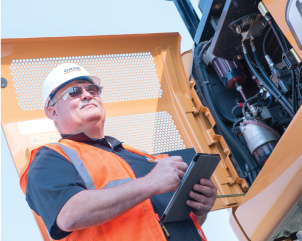Best Practices
Loader Backhoe Operation
Loader backhoe use can be difficult for both new operators, and the most experienced ones. Follow our best practices for safe operation
Preliminary Checkpoints
Prework checklist
- Walk around the machine and verify that all attachments are securely mounted and that all external functions, such as the loading bucket or excavator arm, are operating properly.
- Inside the cab, make sure the seat is in an upright position and the seat belt is working. The seat should be centered, so all of the controls are easily accessible.
- Check the control pattern of your machine to assure it is set for the function you plan on using—excavator or backhoe.
Preparing the site for work
- Know your work area. Look for ground depressions, which can be a sign of potential problems like buried storage tanks.
- Before digging at a site, always call to have buried utilities marked.
In Operation
Creating a safe digging platform
- When preparing for backhoe work, first make sure your machine is fully secure. Check that your stabilizers are out, and, if possible, spread them to their full width. If ground conditions cause the stabilizers to sink, use blocks or cribbing to ensure the stabilizers have solid footing.
- Dig the bucket's cutting edge into the ground. While the added stability of the bucket is important, there are sometimes jobs that require the bucket to be raised.
- Carry the bucket as low to the ground as possible while still clearing obstacles.
Lifting heavy loads
- Make sure your loader backhoe is level and the tires are at least 6" above the ground. Before you lift anything, refer to the machine's specification sheet to verify your machine is capable of handling the weight.
- When lifting loads, keep the boom as close to the machine as possible. Use the shortest chain possible, to minimize the amount of lifting needed to get the load off the ground. Never use any kind of homemade rigging. Lower the RPM of your machine when lifting to allow the vehicle to move steadily, so your load doesn't swing wildly.
Moving materials
- Try not to lift the bucket more than a foot off the ground while transporting materials to avoid an unstable machine and lost visibility. Do not cross hills or slopes with a loaded bucket.
- While operating the machine on an incline, the bucket should be pointed up the hill to keep the machine balanced. If you go down a slope, the machine should be in reverse.
- While repositioning on a rise, keep the machine level at all times. Make sure you never swing the bucket downhill, which can cause the center of gravity to change and the machine to roll. If you need to swing a bucket downhill for any reason, move slowly and keep the bucket as low to the ground as possible.

